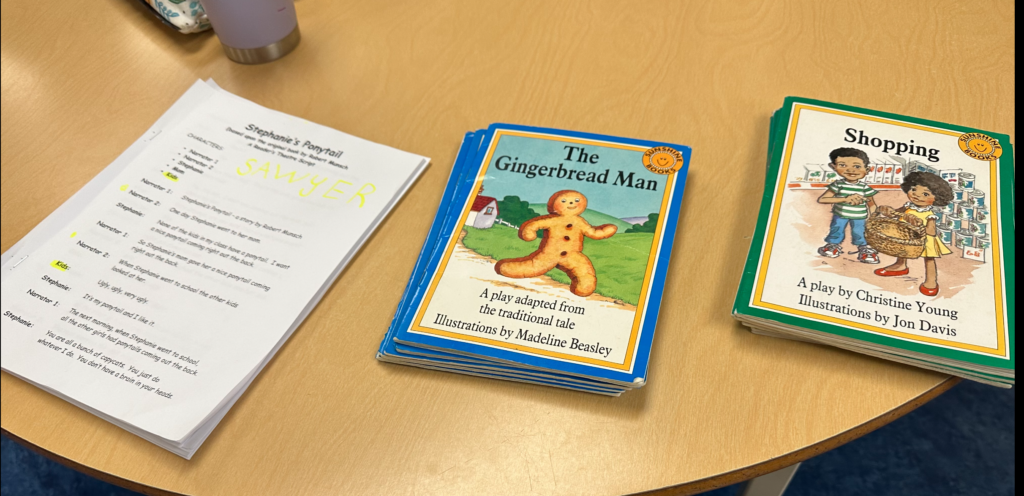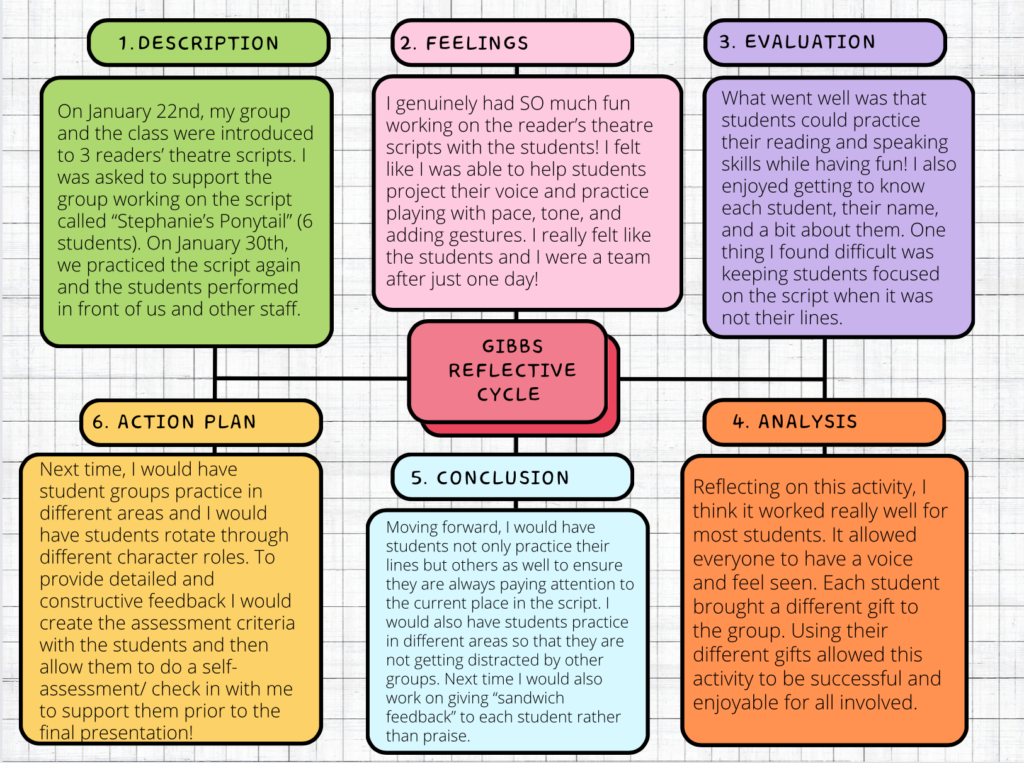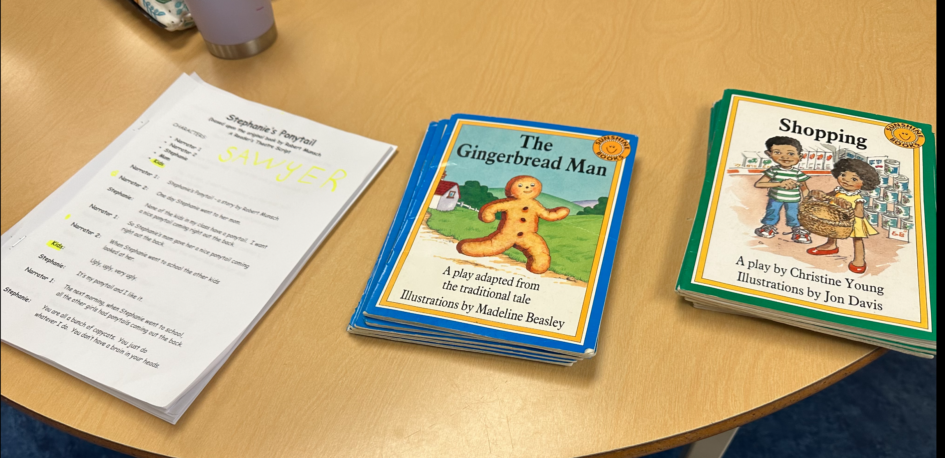Mini Literacy Lesson Through Reader’s Theatre

Connections to the BC Curriculum
Subject: English Language Arts Grade 2 and 3
Big idea (s): “Playing with language helps us discover how language works” (BC Curriculum, ELA 2, 2024). “Using language in creative and playful ways helps us understand how language works” (BC Curriculum, ELA 3, 2024).
Curricular Competencies:
- “Plan and create a variety of communication forms for different purposes and audiences (ie. Readers Theatre)” (BC Curriculum, ELA 2/3, 2024).
- “Read fluently at grade level (reading with comprehension, phrasing, and attention to punctuation)” (BC Curriculum, ELA 2/3, 2024).
- “Engage actively as listeners, viewers, and readers” (BC Curriculum, ELA 2/3, 2024).
Content:
- “Reading strategies (ie. using knowledge of language patterns and phonics to decode words; identifying familiar and “sight” words; monitoring and asking: Does it look right? Sound right? Make sense?)” (BC Curriculum, ELA 3, 2024).
- “Features of oral language (including tone, volume, inflection, pace, gestures)” (BC Curriculum, ELA 2/3, 2024).
Core Competencies:
- Communicating: Profile 5: “I communicate confidently, using forms and strategies that show attention to my audience and purpose” (BC Curriculum, Core Competencies, 2024).
- Collaborating: Profile 2: “In familiar situations, I cooperate with others for specific purposes” (BC Curriculum, Core Competencies, 2024).
- Social Awareness and Responsibility: Profile 2: “In familiar settings, I can interact with others and my surroundings respectfully” (BC Curriculum, Core Competencies, 2024).
Cross-Curricular Connections:
- Arts Education 2/3: This activity connects to arts education because Readers Theatre allows students to engage in a “dramatic form” and if students create props for their presentation this connects to “create artistic works collaboratively and as an individual using ideas inspired by imagination, inquiry, experimentation, and purposeful play” (BC Curriculum, Arts Education 2/3, 2024).
- Physical and Health Education 2/3: This activity connects to PHE because it gives students the opportunity to “apply strategies for developing and maintaining positive relationships” (BC Curriculum, PHE 2/3, 2024).
First Peoples Principles of Learning Connections: For this lesson activity I do not feel that I can meaningfully connect it to the FPPL. Especially given that the reader’s theatre scripts were not written by Indigenous authors.
Description of the Lesson/Activity
Over the last two weeks, I have been fortunate to observe and participate in an activity where the class formed small groups to work on Readers’ Theatre scripts. I am going to take you through all of the steps and suggestions I learned form the teacher to make this work smoothly in your classroom and so that I can refer to this in my future teaching career. It was an absolute success and a blast for all the students in the class. I cannot wait to do this with a class of my own one day!
- Find around three different Reader’s Theatre scripts that the students will relate to. This class used the following three: “The Gingerbread Man” (book), “Shopping” (book), and “Stephanie’s Ponytail” (script). See the title photo for details.
- Read each script as a whole class (Choral read). This allows students to hear the different stories prior to deciding which one they want to do.
- Have a class vote on which script each student wants to do.
- Once the groups have been made and Reader’s Theatre scripts have been assigned to each group, allow the students to disperse and practice.
- Walk around and observe/ support each student with decoding and fluency.
- Next, walk around and emphasize the importance of tone, volume, inflection and pace when presenting the Reader’s Theatre Scripts to the whole class (next class or the following week).
- If time permits, offer students different props to use. You could also give class time in art for students to create props to go along with their characters. The students were very creative! For example, one student created a headband prop to represent their character which was a wolf (see below photo)
- Give students time to practice with their props.
- Ask students to please collect all their props and scripts and hand them in. Place all scripts and materials in a bin for safe-keeping until the following class.

********************* Next class************************
- Soft start: The students entered the classroom and had about 5 minutes to talk with their peers, and retrieve their planners.
- The teacher was extremely flexible with her practice. A student came in wanting to share a mask they created. To make it educational the student came to the front of the classroom and shared how she created it to the rest of the students. From here, the teacher had students ask her questions about it. When students said comments she replied with “how can you turn your comment into a question?”. This was a great way to see how teachers who are flexible can promote the interests of their students while also emphasizing inquiry and building classroom community!
- Next, was a check-in with the students on the carpet while completing attendance. By doing this, the teacher noticed that 6 students from the class were away. This is when the teacher asked the students to be flexible and pick up a few extra parts in the reader’s theatre scripts.
- SHOW TIME! Students were asked to collect their scripts and props and prepare to present.
- The teacher pre-explained expectations (ie. no costumes until you perform, the importance of active listening, the need to project your voice to the audience, say the title of the script at the beginning all altogether and take a bow at the end).
- Students rotated through their reader’s theatre groups. As this was going on the teacher supported all students if they had any difficulty with decoding words or keeping up with the script. I also loved seeing the support of student-student when they helped each other if they were ever stuck.
- It was also very beneficial to have a 30-second stretch break between each group.
- At the end of the reader’s theatre group performances, the students all completed a “PE with Mr.G” on YouTube for a 2-minute movement break. This is a resource I will hold onto in the future when my students need a movement break.
- This concluded our lesson on reader’s theatre to promote literacy in a grade 2/3 classroom.
Participation: Throughout the previous three lessons spent in this grade 2/3 classroom I tried my best to meet each student briefly and offer support by circulating the classroom and modelling wanted behaviour (ie. if the teacher said hands on top that means stop, I would follow along by modelling this so that the students would see it is important for everyone to pay attention).
***********************************************************************************
I just want to touch on one more little activity that we did at the end of our class this morning (January 30, 2024). The teacher introduced us to Reading Power by Adrienne Gear, a B.C educator. How this lesson worked is she began reading a book called “A Difficult Day” by Eugenie Fernandes. Before reading she asked the students to think of different connections they make with the story. After each page, the teacher stopped and asked students if they had made any connections to their lives. I was in awe about how many connections students made to their own lives that they shared with their classmates. The students would then go on to draw a picture of a connection they made to the story and write a blurb about it. The best part is that there is an entire bin of reading power resources at the SD5 District Resource Centre! Adrienne Gear has published a book called “Reading Power” that I would love to look into further one day.

Reflection: Related to the Professional Standards for BC Educators
My reflection on the readers’ Theatre activity through the Gibbs Reflective Cycle:

Connections to the Professional Standards for BC Educators
- “Educators value the success of all students. Educators care for students and act in their best interest” (BCT, 2024). I believe that I fulfilled this by checking in with each student in the group I was supporting. I tried making the group as welcoming and safe as possible by telling the students that I was there to support each of them in feeling comfortable for their final presentation and to have fun while preparing! I fulfilled this professional standard by learning each student’s name and offering support through positive reinforcement.
2. “Educators act ethically and maintain the integrity, credibility, and reputation of the profession” (BCT, 2024). This is of utmost importance not only when I am visiting different schools but 24-7! I believe that professionalism in my teaching and in my own life is extremely important. I do not think it is possible to separate the two. I fulfill this standard by always ensuring the confidentiality of students, showing up in professional attire and wearing my school lanyard with my photo ID. I also show up with a professional attitude by asking questions to process my learning as an educator and record all that I learn as a way to remind my future self of strategies that will benefit all whom I have the pleasure of working with. Lastly, I entered this profession because I want students to be happy and become good citizens and to do this I must depict this myself. I ensure that in my personal life, my social media pages remain professional and whenever I go into public I am dressed appropriately and never talk about confidential information. By doing what I just explained I maintain the reputation of the teaching profession. The teaching profession comes with a huge responsibility to take care of other peoples children and I am so grateful for the trust that the future caregivers of my students will have in me. This is why I will always act ethically and maintain the integrity, credibility, and reputation of the profession for my students.
References
Curriculum. (n.d.-a). https://curriculum.gov.bc.ca/
Gear, A. (2015). Reading power: Teaching students to think while they read. Stenhouse Publishers.
Gear, A. (n.d.). Adrienne Gear. https://www.readingpowergear.com/
G, Mr. (2020, April 28). Pe games: Yoga freeze dance. YouTube. https://www.youtube.com/watch?v=EcnQNWBXE5s
Professional standards – gov. (n.d.-b). https://www2.gov.bc.ca/assets/gov/education/kindergarten-to-grade-12/teach/teacher-regulation/standards-for-educators/edu_standards.pdf

Leave a Reply
You must be logged in to post a comment.